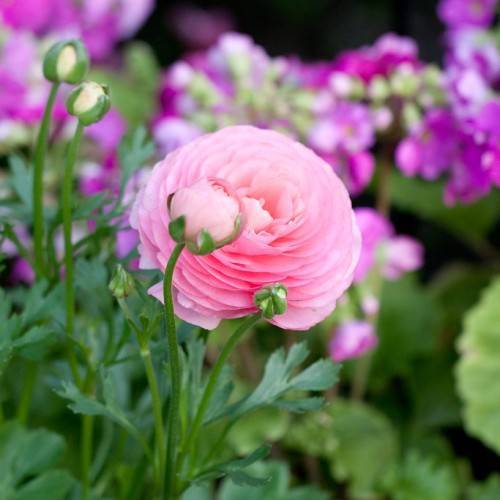
Persian buttercup
Ranunculus asiaticus
Also Known As - Persian buttercupCycle:
Perennial
Watering:
Average
Hardiness Zone:
8 - 10
Flowers:
Flowers
Sun:
Full sun
Fruits:
Fruits Ready In Summer
Leaf:
Yes
Growth Rate:
High
Maintenance:
Moderate
Invasive:
Yes
Care Level:
Medium
watering
Persian buttercup (Ranunculus asiaticus) is a showy annual flower that thrives in humid climates and needs consistent watering to flourish and bloom through autumn. Water Persian buttercup whenever the soil feels dry to the touch. This usually works out to about twice a week during the hottest months of summer. After the initial planting, wait for the soil to dry out before giving it more water. Make sure you provide adequate drainage for Persian buttercup since too much water or wet soil can cause root rot. Using a soil moisture meter can also help gauge when to water.
sunlight
Persian buttercup (Ranunculus asiaticus) prefers full sunlight, meaning direct exposure to the sun for at least 6-8 hours a day. If the plant is grown outdoors in tropical, subtropical, and temperate zones, it should be positioned to get direct sunlight in the morning and filtered sunlight in the afternoon. For indoor plants, direct sunlight can be provided using a sun lamp or placing the pot near a south or west-facing window. In cold winter climates, Persian buttercup may need to be kept indoors with additional lighting to provide the necessary sun exposure. When the plants are grown indoors, they should be exposed to bright, direct sunlight for at least 4-6 hours a day.
pruning
Persian buttercup can be pruned in the early spring or late fall months. Pruning Persian buttercup is not difficult but should be done only after extensive blooming is complete. Before pruning, cut off any dead stems so that the plant looks neat and remove any old flowers and remove any seed heads. When pruning, start by cutting back the main stem to about 1 third of its original length, and prune off any side stems. This encourages new shoots and will help keep the flowers in check. To keep the Persian buttercup looking neat and bushy, prune early in the fall to remove any wilted or dying flowers and shoots, leaving a few green shoots and branches to fill out the foliage. This will also help promote prolific blooming next season.
